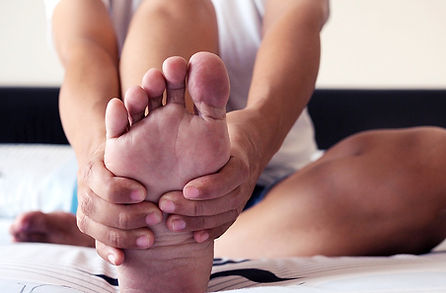Chiropractic Solutions for Neuropathy in Des Moines, IA

What Is Peripheral Neuropathy?
Peripheral neuropathy is a frustrating, life impairing condition that is frequently overlooked until it’s too late to treat effectively.
This disorder involves nerve damage that affects the extremities of the body, such as the arms and legs, with symptoms that often include pain resembling the experience of pressure from pins and needles. It may result from an underlying cause such as diabetic neuropathy, or the disorder can be idiopathic, with no apparent cause.
Common causes of peripheral neuropathy include vitamin deficiencies, injury, and medication. In many cases of peripheral neuropathy, the underlying cause is idiopathic. Fortunately, recent advances in treatment are offering relief even for idiopathic peripheral neuropathy sufferers.
Symptoms of Peripheral Neuropathy:
-
Burning pain
-
Sensitive Skin
-
Cramping
-
Tingling Or Prickly Feelings
-
Leg Or Foot Pain
-
Electrical Shock-Like Pain
-
Increased Risk Of Falling
-
Muscle Weakness
-
Pain Or Muscle Cramping That Disrupts Sleep
-
Impaired Balance
-
Numbness & Pain In Your Hands Or Feet
.png)
New Patient Paperwork
(Click Below)

Some patients describe what are classified as “negative” symptoms. These include early signs associated with nerve damage, such as decreased sensitivity, numbness, weakness, or feeling like their feet or hands are dead or asleep.
Other patients experience what, strangely enough, are categorized as “positive” symptoms. Positive symptoms are present only after the nerves have been sick and damaged for some time. They include sensations like shooting, stabbing or aching pain, burning, tingling, itching, twitching, electrical sensations, pressure or squeezing, throbbing, freezing, or feeling like their socks are balled up underneath their toes. Some patients suffer from both “negative” and “positive” symptoms simultaneously, which is just as unbearable as it sounds!
Some will experience signs indicating impairment of their autonomic nervous system, such as discoloration and temperature changes in their feet or hands. They may have a red, swollen appearance, and feel hot to touch. Others take on a cyanotic blue or purple hue, and are cold due to lack of circulation.
Each patient will experience a different combination of these symptoms. As the condition progresses, symptoms become more severe and have a growing impact on the patient’s quality of life, and on that of his or her family. Standing and walking can become limited and laborious. Balance can become impaired. If the condition is allowed to progress, reduced sensation can become dangerous because of increased risk for falls and resultant injuries. Independent mobility may be threatened.
Some neuropathy sufferers are forced to rely on walking aids, progressing from a cane to a walker, eventually ending up in a wheelchair. Ultimately, loss of independence and reliance on 24/7 aide care or in a nursing home becomes the reality of many. It’s important to begin treating neuropathy as soon as possible to assure nerve damage does not progress to the point that rehabilitation is no longer possible.
Thankfully, due to advances in neuroscience and technological breakthroughs, many neuropathy sufferers can now slow or stop the progression of their condition, and experience relief of pain and restoration of sensation, balance, strength, and mobility.
In many cases, the initial symptoms are mild, but worsen over time - moving from the toes to the feet, the legs and can even affect the hands.
Treating Peripheral Neuropathy
When it comes to the conventional treatment options available for peripheral neuropathy, many patients choose medication to alleviate their symptoms. The most common medical treatment consists of prescription drugs, such as Gabapentin, Neurontin, Lyrica and Cymbalta.
Unfortunately, these prescription medications interact with all of your nerves. They may relieve the pain that neuropathy can cause, but they won’t treat the underlying condition. There are better options available for sufferers today, and you can choose the treatment option you believe is best for your health.
Benefits of Chiropractic Treatment for Peripheral Neuropathy
Many people choose chiropractic care to fight this disorder. This solution gives sufferers a noninvasive yet effective way to treat their condition. There are several causes of neuropathy, ranging from diabetic neuropathy to chemotherapy treatment and nerve compression syndromes.
Chiropractic care treats peripheral neuropathy by targeting affected areas with physical therapy. Patients who receive this treatment report a significant reduction in their symptoms. Each session improves the condition of the extremities, and the pain will slowly decline with chiropractic care.
Peripheral neuropathy sufferers respond well to this method because it focuses on their pain. Chiropractic therapists take the time to understand why the patient is experiencing symptoms, and their solution focuses on alleviating those concerns. After examining the source of the problem, the therapy sessions can begin.
Sufferers should notice relief even if they’re experiencing a chronic case of peripheral neuropathy. If symptoms persist, we can try a different approach. We work with you to understand and treat your peripheral neuropathy pain.


